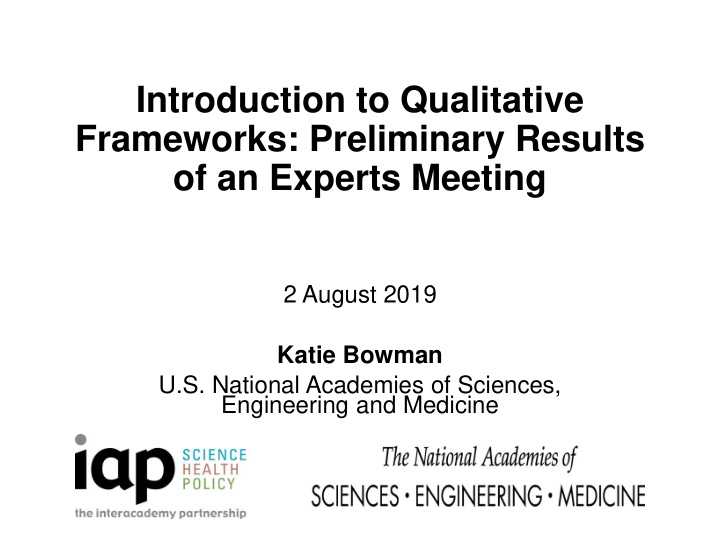



Introduction to Qualitative Frameworks: Preliminary Results of an Experts Meeting 2 August 2019 Katie Bowman U.S. National Academies of Sciences, Engineering and Medicine
Approaches to Assessing S&T • Many types of approaches to assessing potential risks and benefits of advances in S&T • From formal, quantitative models through statistical approaches to qualitative tools • All the approaches potentially relevant to the BWC • Our efforts focused on one approach – qualitative frameworks – that can be used to structure systematic discussions among experts • One feature of our approach – a group process 2
What is a Framework? • A mental model • A way to think about a problem • A list of decision criteria • A representation of expert thinking on an issue 3
How a Framework Can Be Useful • Helps structure discussions in systematic way • Helps standardize terminology to make sure everyone is talking about the same thing • Helps clarify assumptions, open questions, and areas of agreement or disagreement • Provides a mechanism to incorporate technical experts in the assessment • Can engage experts from various fields and from different sectors 4
Experts Meeting – 1 August • Diverse international group of 30 experts from 17 countries and 3 international organizations • Applied two frameworks developed to assess potential concerns arising from S&T advances • US NASEM (2018) “Biodefense in the Age of Synthetic Biology” • Tucker (2012) “Innovation, Dual Use and Security” 5
The NASEM Framework 6
The Tucker Framework 7
Case Examples Tested the frameworks using two case examples • Change in transmissibility of an emerging viral pathogen • Engineering and controlling commensal bacteria for targeted “live” therapeutics 8
Applying the Frameworks • Both frameworks were useful in structuring the information to enable conversations. • Such structures could also be used to present information on risks in a way that facilitates comparisons • It could be useful to pilot test this type of analysis using qualitative frameworks with additional groups and additional case examples to continue learning how they can be adapted for the BWC • We began a discussion on how to enable structured analysis of benefits. 9
Key Messages • Risks can be assessed in a systematic way to inform policy makers • Assessments can be carried out at the national level or as a collective process under the BWC • These qualitative frameworks can be applied by experts from any States Party • This process helps organize the information to support evidence-informed policy • These activities can promote understanding of the benefits of technologies to implement Article X of the BWC • The ultimate decisions on what actions to take in response to the assessments would be made States Parties 10
Thank You! References: • National Academies of Science, Engineering, and Medicine, Biodefense in the Age of Synthetic Biology . Washington, DC: National Academies Press Washington, DC: National Academies Press (2018). Available as a free pdf at https://www.nap.edu/catalog/24890/biodefense-in-the-age-of- synthetic-biology. • Jonathan B. Tucker (ed.), Innovation, Dual Use, and Security : Managing the Risks of Emerging Biological and Chemical Technologies . Cambridge, MA: The MIT Press (2012). 11
More recommend